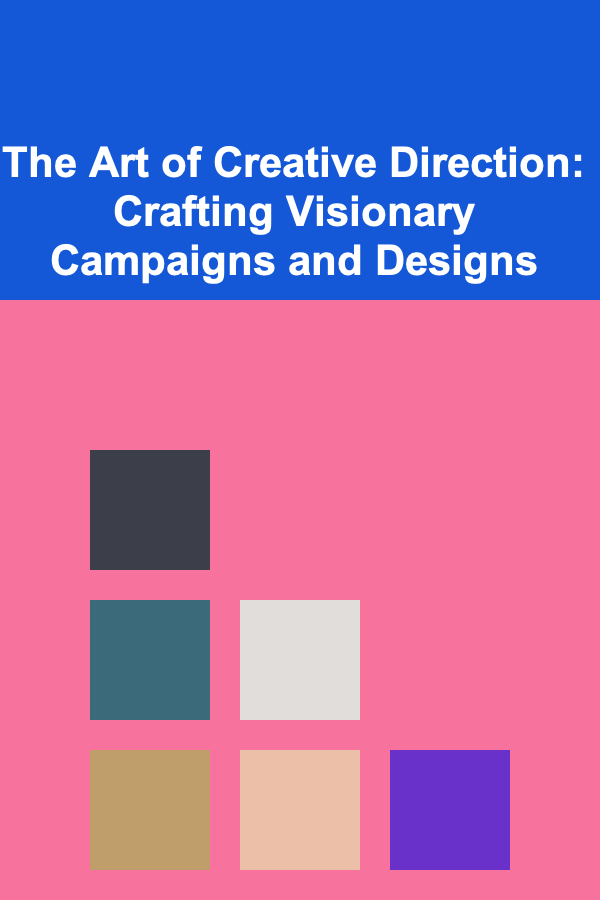
The Art of Creative Direction: Crafting Visionary Campaigns and Designs
ebook include PDF & Audio bundle (Micro Guide)
$12.99$9.99
Limited Time Offer! Order within the next:

Creative direction is a multifaceted art that blends inspiration, strategy, and leadership. It is not merely about overseeing a project; it is about shaping and guiding the creative journey from concept to execution. A creative director's role involves crafting visionary campaigns and designs that are not only aesthetically compelling but also strategically aligned with the brand's goals. The ability to drive innovation while ensuring consistency and cohesion is the hallmark of great creative direction.
In this comprehensive guide, we will explore the art of creative direction in detail, offering practical insights on how to craft impactful campaigns and designs. From defining your vision to leading teams and adapting to evolving trends, this article will provide a roadmap for creative professionals looking to refine their craft and deliver work that resonates.
Defining the Creative Vision
The foundation of any successful creative campaign or design is a strong, clear vision. As a creative director, you are responsible for formulating that vision and ensuring it permeates every aspect of the project. A creative vision isn't just about artistic ideas; it's about creating a narrative that is in line with the brand's identity, audience, and objectives.
Key Steps to Crafting a Creative Vision:
- Understand the Brand's Identity: Before you can create something that is visually and conceptually strong, it is crucial to understand the brand at its core. Dive deep into the brand's mission, values, and tone. A brand's visual and messaging identity should always be a reflection of these elements.
- Define the Campaign's Objective: What is the purpose of the campaign or design? Are you looking to increase awareness, drive sales, or promote a new product? Understanding the end goal will guide your creative choices. A strong vision should be built around these objectives, ensuring the creative output serves a greater purpose.
- Identify the Target Audience: Your creative vision must resonate with your audience. Who are you trying to connect with? Understanding their preferences, pain points, and emotional triggers will allow you to craft campaigns and designs that speak directly to them.
- Create a Unifying Concept: The best campaigns and designs are built around a central theme or concept. This can be a visual motif, a tone, or a narrative that ties everything together. Whether it's a visual style, a message, or a feeling, a unifying concept ensures coherence throughout the project.
Bringing Ideas to Life: The Role of Conceptualization
Once the vision is defined, the next step is to bring it to life. Conceptualization is the phase where ideas start to take shape, and the vision transitions into tangible assets. It's the creative director's job to guide this process, ensuring that the concepts remain true to the vision and meet the project's objectives.
Key Steps in Conceptualization:
- Collaborate with Your Team: Creative direction is rarely a solo effort. Involve your team early in the process to brainstorm and refine concepts. Whether it's designers, copywriters, illustrators, or photographers, input from different perspectives can enrich the creative process and push boundaries.
- Sketch and Prototype: Concept sketches or prototypes are essential in visualizing the initial idea. They give both you and your team a roadmap for how the final product will look. Don't be afraid to iterate and refine during this phase---great ideas often evolve through multiple iterations.
- Refine the Concept with Feedback: Once initial concepts are presented, collect feedback from key stakeholders and your team. Critique should focus on how well the concept aligns with the vision and objectives. Iterate based on constructive feedback, ensuring the design or campaign is evolving in the right direction.
Leading the Creative Team: Building a Collaborative Environment
Creative direction is as much about leadership as it is about vision. A creative director must inspire and guide their team while fostering a collaborative, open-minded environment. The most successful creative projects are often the result of collective effort, where each team member brings their unique talents and expertise.
Key Strategies for Effective Leadership:
- Set Clear Expectations: Make sure everyone understands the project's goals, timelines, and their specific roles. Clear communication at the outset helps ensure that all team members are aligned and working toward the same outcome.
- Foster Creativity Through Trust: Allow your team members to take risks and explore their own creative ideas. Trusting your team to bring their best ideas forward encourages innovation and fosters a more dynamic work environment.
- Encourage Constructive Feedback: Foster a culture of feedback, where critiques are thoughtful, respectful, and aimed at improving the work. Creating a safe space for feedback ensures that ideas can be discussed openly and improved upon collaboratively.
- Be a Source of Inspiration: As the leader of the creative team, you must maintain enthusiasm and passion for the project. Inspire your team through your own creativity, attitude, and work ethic. Your energy and dedication will fuel the team and keep them motivated through the creative process.
Balancing Creativity with Practicality
While creativity is the lifeblood of any campaign or design, it must be balanced with practical constraints, including budgets, timelines, and client expectations. A creative director must know how to navigate these constraints without sacrificing the integrity of the vision.
Key Approaches to Balancing Creativity and Practicality:
- Know Your Limits: Set realistic timelines and budgets from the start. Understanding the resources available allows you to plan accordingly and avoid compromising creativity due to unforeseen limitations.
- Prioritize the Essential Elements: Focus on the key aspects that will have the most impact. Whether it's a striking visual, a clever tagline, or a powerful message, ensure that the most crucial elements of the campaign or design receive the most attention.
- Optimize Resources: Get the most out of your available resources. This might mean repurposing existing assets, leveraging in-house tools, or using cost-effective solutions. Resourcefulness ensures that creativity isn't hindered by external limitations.
- Stay Agile: The creative process can be unpredictable. You might encounter challenges that require you to pivot or adapt. Flexibility and adaptability are essential for navigating the creative journey without sacrificing the overall vision.
Innovating with Trends and Technology
In an ever-evolving creative landscape, staying ahead of trends and technological advances is critical. Creative directors must not only keep up with industry developments but also use them to fuel innovation and create cutting-edge campaigns and designs.
Key Strategies for Embracing Innovation:
- Stay Informed on Trends: Follow industry publications, attend conferences, and engage with thought leaders to stay informed on the latest trends. Whether it's in design, digital marketing, or technology, being ahead of the curve allows you to incorporate new ideas into your work.
- Adopt Emerging Technologies: Explore new tools, software, and platforms that can elevate your creative output. From AI-assisted design tools to immersive technologies like virtual reality, using innovative technologies allows you to push the boundaries of what's possible.
- Experiment and Take Risks: Encourage experimentation within your team. While it's important to be grounded in the brand's identity, don't be afraid to take creative risks. Trying new styles, formats, or techniques can lead to breakthroughs that captivate your audience.
Ensuring Consistency Across Touchpoints
Consistency is key when it comes to creating a cohesive brand experience. Whether it's an advertising campaign, product packaging, or website design, the creative director must ensure that all visual and messaging elements align with the brand's identity and tone across different platforms.
Key Approaches to Maintaining Consistency:
- Develop Clear Brand Guidelines: Establish comprehensive guidelines that cover the brand's visual identity, tone, and messaging. These guidelines should be followed across all creative assets to maintain consistency.
- Audit and Refine Assets: Periodically review creative work to ensure it aligns with the brand's identity and vision. This allows you to identify areas where the brand may have deviated and make necessary adjustments.
- Adapt While Staying True to Core Values: While consistency is important, it's also essential to evolve the brand over time. Refine the brand's look or messaging to stay relevant without losing sight of the core values that define it.
Measuring the Impact of Creative Work
Creative direction should always be tied to measurable outcomes. After all, great creative work is about more than just artistic expression---it's about delivering results. Whether it's increasing brand awareness, driving sales, or improving customer engagement, the impact of your work must be assessed to understand its effectiveness.
Key Approaches to Measuring Impact:
- Set Clear Objectives: Establish clear goals and KPIs (key performance indicators) for each project. Whether it's engagement metrics, sales conversions, or audience reach, defining success upfront ensures that the creative work is aligned with measurable outcomes.
- Use Analytics to Track Performance: Implement tools and systems to track the performance of your campaigns and designs. This data provides insights into how the creative work resonates with the audience and whether it's achieving the desired impact.
- Refine Based on Data: Use data to refine future creative decisions. If a campaign is underperforming, analyze the results and make adjustments for the next iteration. Continual improvement is the key to long-term success.
Conclusion
Creative direction is a blend of artistry, strategy, and leadership. It requires the ability to envision bold ideas, guide a team toward a common goal, and balance creativity with practicality. Whether you're crafting a visionary campaign or leading a design team, the principles outlined in this guide will help you hone your craft and produce work that resonates deeply with your audience while achieving business objectives.
Ultimately, great creative direction is about making connections---between the brand and its audience, between the vision and the execution, and between creativity and impact. By mastering these elements, you can lead your team to create truly visionary campaigns and designs that leave a lasting impression.

How to Incorporate Hidden Storage in Your Decor
Read More
How to Make Extra Income by Designing Websites from Home
Read More
How to Organize Antique Books and Ephemera Effectively
Read More
How to Track and Improve Your Net Worth
Read More
How to Transform Your Bedroom into a Serene Retreat
Read More
The Ultimate Guide to Free Online Courses for Personal and Professional Growth
Read MoreOther Products

How to Incorporate Hidden Storage in Your Decor
Read More
How to Make Extra Income by Designing Websites from Home
Read More
How to Organize Antique Books and Ephemera Effectively
Read More
How to Track and Improve Your Net Worth
Read More
How to Transform Your Bedroom into a Serene Retreat
Read More